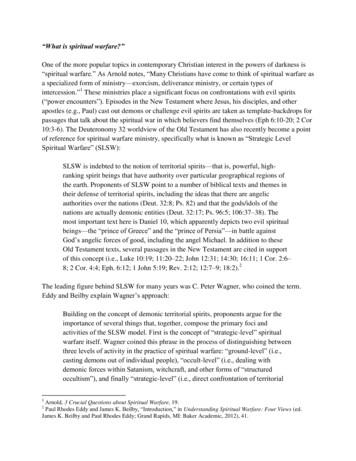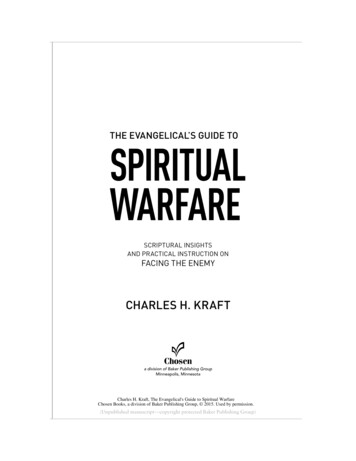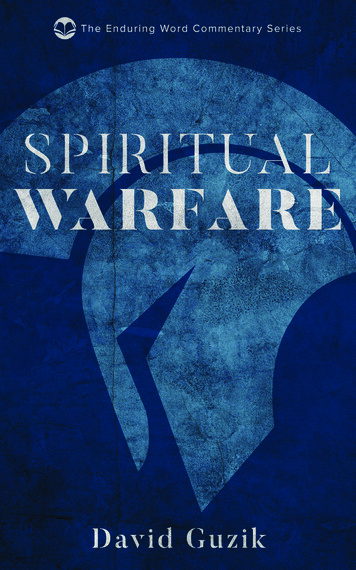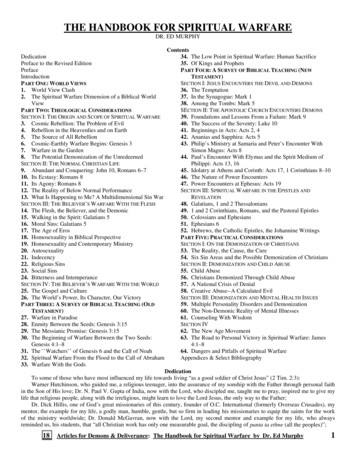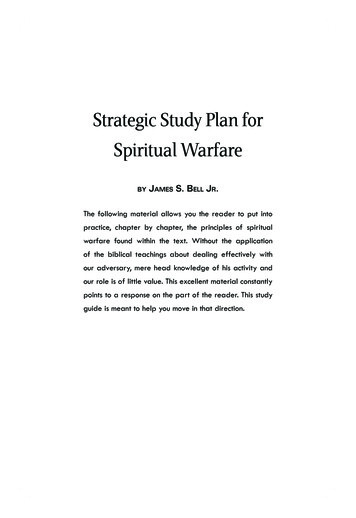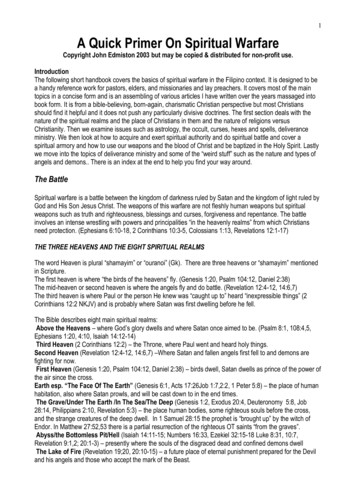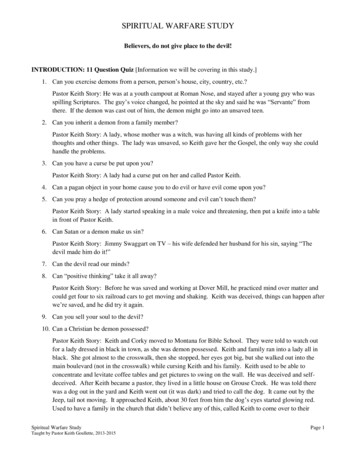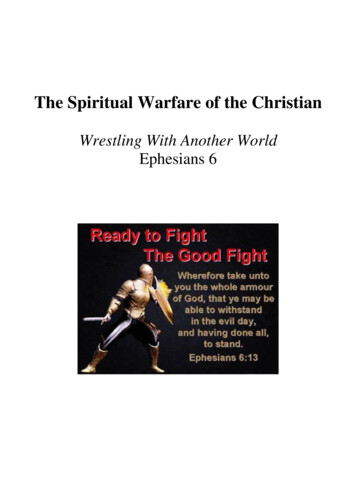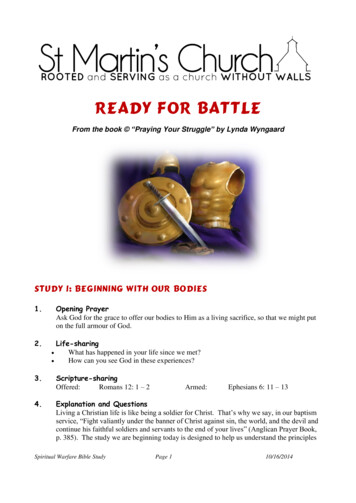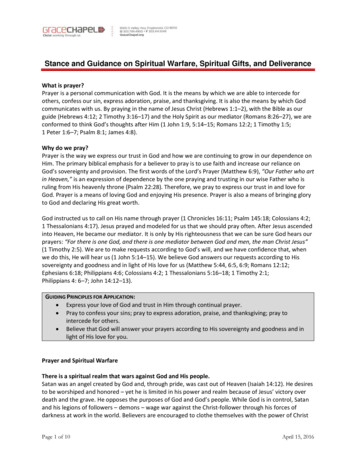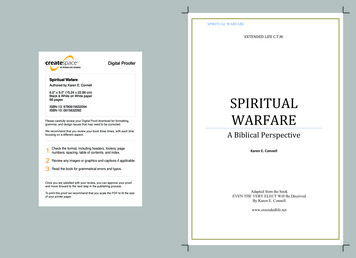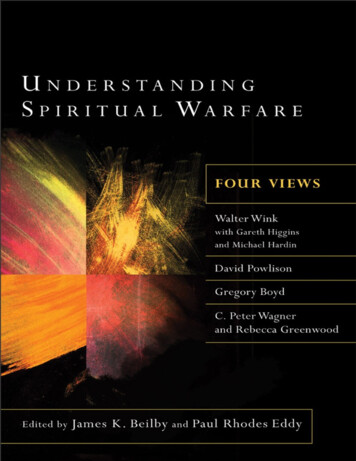
Transcription
2012 by James K. Beilby and Paul Rhodes EddyPublished by Baker Academica division of Baker Publishing GroupP.O. Box 6287, Grand Rapids, MI 49516-6287www.bakeracademic.comEbook edition created 2012All rights reserved. No part of this publication may be reproduced, stored in aretrieval system, or transmitted in any form or by any means—for example,electronic, photocopy, recording—without the prior written permission of thepublisher. The only exception is brief quotations in printed reviews.ISBN 978-1-4412-4013-2Library of Congress Cataloging-in-Publication Data is on file at the Library ofCongress, Washington, DC.Material from Walter Wink reproduced by permission of Augsburg FortressPublishers.Unless otherwise indicated, Scripture quotations are from the Holy Bible, NewInternational Version . NIV . Copyright 1973, 1978, 1984, 2011 by Biblica,Inc. Used by permission of Zondervan. All rights reserved worldwide.www.zondervan.comScripture quotations labeled author’s translation or author’s paraphrase are theauthor’s own translation.Scripture quotations labeled ESV are from The Holy Bible, English StandardVersion (ESV ), copyright 2001 by Crossway, a publishing ministry of GoodNews Publishers. Used by permission. All rights reserved. ESV Text Edition: 2007
Scripture quotations labeled GNT are from the Good News Translation—SecondEdition. Copyright 1992 by American Bible Society. Used by permission.Scripture quotations labeled Jerusalem Bible are from THE JERUSALEM BIBLE,copyright 1966 by Darton, Longman & Todd, Ltd. and Doubleday, a division ofRandom House, Inc. Reprinted by permission.Scripture quotations labeled KJV are from the King James Version of the Bible.Scripture quotations labeled NASB are from the New American Standard Bible ,copyright 1960, 1962, 1963, 1968, 1971, 1972, 1973, 1975, 1977, 1995 byThe Lockman Foundation. Used by permission. www.lockman.orgScripture quotations labeled NET are from the NET BIBLE , copyright 2003 byBiblical Studies Press, LLC. www.netbible.com. Used by permission. All rightsreserved.Scripture quotations labeled NKJV are from the New King James Version.Copyright 1982 by Thomas Nelson, Inc. Used by permission. All rightsreserved.Scripture quotations labeled NRSV are from the New Revised Standard Version ofthe Bible, copyright 1989, by the Division of Christian Education of theNational Council of the Churches of Christ in the United States of America. Usedby permission. All rights reserved.Scripture quotations labeled REB are from the Revised English Bible 1989Oxford University Press and Cambridge University Press.Scripture quotations labeled RSV are from the Revised Standard Version of theBible, copyright 1952 [2nd edition, 1971] by the Division of Christian Educationof the National Council of the Churches of Christ in the United States of America.Used by permission. All rights reserved.
Scripture quotations labeled TNIV are from the Holy Bible, Today’s NewInternational Version . TNIV . Copyright 2001, 2005 by Biblica, Inc. Usedby permission of Zondervan. All rights reserved worldwide. www.zondervan.comThe internet addresses, email addresses, and phone numbers in this book areaccurate at the time of publication. They are provided as a resource. BakerPublishing Group does not endorse them or vouch for their content orpermanence.
Dedicated to Albert C. Bender and Judie O’BrienDedicated to Uncle Al, who is the definition of a“lifelong learner.” Thank you for years of wisecounsel and stimulating conversations.—JimDedicated to my aunt, Judie O’Brien.Your love and encouragement mean more to methan you’ll ever know. You are to me “the aunt thanwhich none greater can be conceived”!Thank you, Auntie.—Paul
ContentsCoveriTitle PageiiiCopyright PageDedicationivvAcknowledgmentsixIntroduction, by James K. Beilby and Paul Rhodes Eddy 11. The World Systems Model, by Walter Wink, edited by GarethHiggins47Response by David PowlisonResponse by Gregory Boyd7278Response by C. Peter Wagner and Rebecca Greenwood2. The Classical Model, by David Powlison89Response by Walter Wink and Michael Hardin112Response by Gregory Boyd84117Response by C. Peter Wagner and Rebecca Greenwood1233. The Ground-Level Deliverance Model, by Gregory Boyd129
Response by Walter Wink and Michael HardinResponse by David Powlison158163Response by C. Peter Wagner and Rebecca Greenwood1694. The Strategic-Level Deliverance Model, by C. Peter Wagner andRebecca Greenwood173Response by Walter Wink and Michael HardinResponse by David PowlisonResponse by Gregory BoydNotes204210215Contributors217Index of Authors and SubjectsIndex of ScriptureBack Cover240228220199
AcknowledgmentsThe list of people that have helped us bring this book tocompletion is long. We are thankful for the excellent work,patience, and flexibility of our contributors—Greg Boyd, DavidPowlison, Walter Wink, Peter Wagner, and Rebecca Greenwood.During the final stage of the editorial process, we learned with greatsadness of Walter’s passing. It is a high honor for us to havepartnered with Walter on one of his final writing projects. We arealso very thankful to Gareth Higgins and Michael Hardin for helpingWalter bring his voice to this conversation during a period of failinghealth. Gareth edited Walter’s initial essay and Michael coauthoredthe responses with Walter. We are also thankful for the work andencouragement of our publisher at Baker Academic, Bob Hosack,and to Bethel University for supporting this work in a variety ofways, including providing Paul with a sabbatical in the spring of2011. In addition, Jim’s teacher’s assistant, Zac Bush, read portionsof the manuscript and offered helpful suggestions. As always, ourfamilies have been an invaluable source of support for all of ourendeavors, academic and otherwise. Words are insufficient toconvey our appreciation. Finally, we would like to dedicate this
book to Albert C. Bender (Jim’s uncle) and Judie O’Brien (Paul’saunt). Thank you for your encouragement and love.
IntroductionIntroducing Spiritual Warfare: A Survey ofKey Issues and DebatesPaul Rhodes Eddy and James K. Beilby“Finally, be strong in the Lord and in the strength of his power. Puton the whole armour of God, so that you may be able to standagainst the wiles of the devil. For our struggle is not against enemiesof blood and flesh, but against the rulers, against the authorities,against the cosmic powers of this present darkness, against thespiritual forces of evil in the heavenly places” (Eph. 6:10–12 NRSV).These words of the apostle Paul have echoed down the corridors ofchurch history. For two millennia, they have inspired Christianstoward courageous living, wise discernment, engaging prayer, andbold action. They have also served as one of the common sites ofexegetical skirmish in a long-running intra-Christian dialogue anddebate about the nature and extent, the biblical and theologicalmoorings, and the rational, experiential, and practical implicationsof what has come to be known simply as “spiritual warfare.”
Some issues of interest and dialogue within the church have theirday in the sun and then, for all practical purposes, disappear.Others, however, never really leave us. They may ebb and flow; theymay have seasons of higher or lower profile; they may findthemselves the subject of a larger or smaller number of bookspublished in any given year. But in one way or another they remainon the church’s radar. Spiritual warfare appears to be one of theseissues. From pulpit sermons to religious radio, from internetwebsites to conference halls to the quarterly catalogs of Christianpublishers (both trade and academic; fiction and nonfiction), thetopic of spiritual warfare never seems to grow old. This shouldn’treally surprise us. The perpetual interest within the church regardingthe things of spiritual warfare is mirrored by the seeminglyinsatiable fascination within our wider culture(s) for thingsmysterious and transcendent, things otherworldly—and things evena bit frightening. But for the church, it is not simply the interest inthis topic that is perennial. When it comes to the issue of spiritualwarfare, the other realities that can be counted on are disagreementand debate.Unfortunately, within the contemporary church, much of thedisagreement and debate surrounding this topic has beencharacterized by more heat than light. Often, there has been moredouble monologue than dialogue, more talking at each other or pasteach other than with each other. This book provides a forum in whichseveral of the important perspectives and representative voices onspiritual warfare are able to meet and interact. This essay will assist
in setting the stage for conversation by offering an introduction tothree of the broad issues that inform the contemporary discussion onspiritual warfare: (1) the moral objection to “spiritual warfare”language; (2) the existence and nature of spirit beings, with a focuson Satan and the demonic; and (3) Christian perspectives on thetheology and practice of spiritual warfare itself. Along the way,something of a bibliographical map to the terrain will be provided(primarily in the footnotes), which will offer further avenues tothose wishing to go deeper on a particular topic. This essay will endby introducing our contributors to this volume, who together offer ahost of rich insights on our topic and provide a model of whathonest, respectful, challenging, and fruitful dialogue on spiritualwarfare can look like.The Moral Objection to “Spiritual Warfare”Language: A ResponseThe first issue to be considered involves an important question thatthreatens to close down the discussion of spiritual warfare before iteven begins. It is a question that emerges just as often from outsidethe church as within. It is the question of whether encouragingChristians to think about and engage in “spiritual warfare” against“evil forces” at work in the world does more harm than good. Simplyput, doesn’t the whole idea of “spiritual warfare” ultimately fosterthings like self-righteousness, intolerance, and even violence?Doesn’t “spiritual warfare” language encourage people to naively
imagine that everything and everyone in the world falls into one oftwo simplistic categories of “good” and “evil,” where “good” isalways linked to “us,” and “evil” is always associated with “them”?Hasn’t this sort of thinking and talking led to an endless stream ofarrogance, judgmentalism, and suspicion—not to mentioninquisitions, holy wars, witch burnings, and genocide? This is animportant question, and it comes in different forms from variousquarters.For a relative few, the problem is to be found in appealing to thevery idea of “evil” itself. They argue that it would be better if westopped using this four-letter word, since it encourages us to believein mythological monsters that do not exist (e.g., Satan) and/or todemonize certain people by categorizing them as “inhuman.”[1]Taking a cue from the postmodern turn inspired by the intuitions ofFriedrich Nietzsche, some see the very ideas of “good” and “evil” as“archaic categories” that simply mask bids for power to define anddominate others.[2] For most people, however, this is a position thatis difficult to take seriously, let alone to hold to consistently. Evenfor the average postmodern materialist/atheist, recent horrors of thelast hundred years alone—including two world wars, the Naziholocaust, the human sex-trafficking industry, and other systems ofexploitation and oppression—are usually enough to convince themthat “evil” is a fact of human existence.[3]And so, for most, the concern over the use of spiritual warfarelanguage is due not to evil’s nonreality but to its all-too-realpresence in our world. Not surprisingly, this concern seems to have
grown over the last decade. It reflects the growth of a wider concernfor any and all forms of religiously motivated hate and violence thathas taken place under the shadow of the 9/11 tragedy.[4] Nahi Alonand Haim Omer have recently argued for an inevitable link betweenuse of the concept/language of the “demonic” and a host ofdangerous relational attitudes and practices. They write:The demonic view is a way of experiencing an evolving attitude that beginswith doubt, thrives with suspicion, ends with certainty, and aims at decisivemilitant action. When it seeps into a relationship, a highly negative view ofthe other evolves, which in turn may lead to symmetrical counter accusations.Thus a vicious cycle arises in which both sides become more and moreentrenched in their negative positions.[5]The wider concern regarding religiously motivated violence hasbecome a common plank among proponents of the “new atheism,”who argue for an inherent relationship between religion,intolerance, and violence.[6] But in the post-9/11 world, it is usuallynot just “religion” in general that falls under suspicion—moreparticularly it is the three monotheistic, “Abrahamic” faiths ofJudaism, Christianity, and Islam that are regularly charged withinciting such evils. With regard to Christianity in particular,arguments include monotheism’s inherent intolerance andoppression; the long history of the church’s involvement with hatred,bloodshed, and warfare; and the presence of divinely sanctionedviolence throughout the Bible itself, in both the Old and NewTestaments.[7]
This is not the place to offer a full-scale response to these charges,of course, but it is important to note that each line of argument herehas been thoughtfully considered and convincingly answered byscholars who, although equally concerned about the misuse ofreligion (or Christianity in particular) to justify intolerance andviolence, see the evidence quite differently.[8] For instance, anumber of studies have demonstrated that monotheism per se is notmore inherently intolerant or oppressive than any other worldview.[9] Clearly, monotheistic religions—including the Christian religion—can and have been used by people and groups over the centuriesto legitimize their own political aspirations and justify violentagendas. But it is important to distinguish empirical correlation fromcausation—and many critics of monotheism regularly confuse thetwo.[10] As Miroslav Volf has argued, “Neither the character of theChristian faith (its being a religion of a monotheist type) nor itsmost fundamental convictions (such as that God created the worldand is engaged in redeeming it) are violence inducing. The Christianfaith is misused when it is employed to underwrite violence.”[11]With regard to the intolerance and violence that have attached tothe Christian religion, no one can seriously deny the many instancesof correlation through history. Many Christians themselves haveregularly pointed this out and mourned the tragic pattern.[12] But,once again, careful consideration has demonstrated that thiscommon correlation is not a sign of Christianity’s inherentintolerance and proneness to violence but rather a sign of the factthat any religious or philosophical system can be used—and misused
—for self-centered ends and political gains.[13] Even the vastmajority of the critics of Christian violence readily acknowledge thatthe original vision and movement inaugurated by Jesus was one ofremarkable inclusiveness, principled nonviolence, and self-givingagapē-love.[14]And here is where the moral objection to spiritual warfare is mostclearly seen. Some will grant that Christian monotheism is notinherently oppressive. But they will argue that it is the segmentswithin Christian theism that traffic in spiritual warfare languagethat tend to become oppressive. The concern is that using thebiblical language associated with “spiritual warfare” will leadChristians to embrace and imitate the whole range of biblical textson “warfare,” including the intolerance and divinely sanctionedviolence in the Bible itself. Even more pressing is the concern thatChristians who take spiritual warfare seriously will reframe theirown human enemies as “God’s enemies”—enemies who, perhaps,are today no less deserving of violent judgment than the Canaaniteswere in the time of the ancient Israelites.To the ears of many, “spiritual warfare” sounds uncomfortablyclose to the language of “holy war.” And holy war—with its “warriorGod,” Yahweh, and its divinely authorized violence against the“enemies” of God’s people—is a common theme found throughoutthe Old Testament.[15] Critics remind us that the Old Testamentholy war tradition always included a component of “spiritualwarfare.” As the Old Testament itself reveals, the Israelites believedthat the spiritual and physical worlds were deeply interwoven, such
that as they conducted war against human enemies, God and hisangels led the way in the spiritual realm (2 Sam. 5:24; cf. 2 Kings6:15–17; 1 Chron. 12:22). Both Jews and Christians have wrestledwith the themes of divinely sanctioned warfare and violence in theHebrew Bible/Old Testament for centuries.[16] Within recentscholarship, responses include the following: (1) emphasizing thatIsrael’s role in warfare is downplayed, as God commands them totrust in him rather than in their military might;[17] (2) proposalsthat the depiction of Israel’s violent conquest of cities in the HolyLand may represent attacks on military forts, or are instances ofpolitical propaganda and, perhaps, never really happened at all;[18] (3) reminders that Israel was itself an oppressed group and thatthe themes of violence are part of a “survival strategy” of atraumatized people;[19] and (4) suggestions that, for example,“divine judgment” in the Old Testament is essentially enactedthrough the natural consequences of sin (which can include war), orthat the “final form” of the violent book of Joshua is actually aprotest against war itself.[20] Some have even argued that we havesimply missed the ironic “beauty” of some of the terrible andgrotesque realities associated with God’s warrior-like nature in theOld Testament.[21] However they explain it, most Christians see theholy war tradition in the Old Testament as one of the many thingsthat have changed for the people of God with the coming of JesusChrist and the new covenant.But it is not just the Old Testament and its holy war tradition thatraises concerns. As mentioned above, elements of the New
Testament itself have also come under scrutiny as inspired sources ofintolerance, bigotry, and violence. The most common culprits here—including the claim of being the one, true religion and the threat ofdivine judgment and eternal torment in hell for all outsiders whoreject the faith—often are traced back to a common villainoussource: namely ancient Jewish apocalyptic eschatology, particularlyits exclusivist and militant attitudes fueled by violent images ofimminent divine judgment upon outsiders.[22] And here is wherecritics of “spiritual warfare” make the connections explicit: the OldTestament “holy war” tradition fed into the Jewish apocalypticeschatology that developed during the intertestamental period. Next,Jesus and the early church affirmed and embraced apocalypticeschatology with its “spiritual warfare” language.[23] It is thisapocalyptically influenced “spiritual warfare” language that thechurch continues to use today. In this light, critics can seeapocalyptic eschatology as little more than “a pathological state ofthe religious mind,” and an impetus to a number of religious andmoral ills fueled by intolerance toward, and demonization of, the“Other.”[24]Over the last two centuries, a range of scholarly reactions haveemerged in response to the question of the relationship of Jewishapocalyptic eschatology to Jesus and the early church. At one end ofthe spectrum, some have interpreted Jesus as a full-on apocalypticJewish prophet in the traditional sense. That is to say, Jesusexpected and preached the imminent end of the present world orderthrough the in-breaking of God’s decisive judgment. The point of
debate within this perspective is whether Jesus believed that he andhis followers were to take an active (i.e., military action) or a morepassive (i.e., trust and wait for God to bring the judgment) role.While a few have proposed the former view—i.e., a “zealot Jesus”—most within this broader camp have assumed the latter.[25]At the other end of the spectrum—and at least in part to avoidassociating Jesus with the attitudes of vengeance and violenceconnected to Jewish apocalyptic thought—some have argued that,although the Judaism he emerged from and the church he gave birthto were both apocalyptically oriented, Jesus himself was not. Thishas the effect of “saving” Jesus from his apocalyptic Jewish context,only to transform him into something like a Greco-Roman Cynicphilosopher or a nonviolent rabble-rouser whose only real ambitionwas to encourage communal living while challenging the oppressiveelites associated with the empire.[26] This approach also has thestrange effect of removing Jesus from his historical setting andraises the question of why his early followers maintained crucialaspects of Jewish apocalyptic eschatology if Jesus himself rejectedthem.However, a sizable number of scholars argues that things are farmore complex than either of these first two views suggests. Itappears that the most plausible interpretation of the historical andbiblical data leads to the conclusion that both views aresimultaneously right—and wrong! The “apocalyptic Jesus”advocates are correct that Jesus and the early church were in factdeeply shaped by much of the basic theological narrative and some
of the essential features of Second Temple apocalyptic eschatology.[27] However, the “non-apocalyptic Jesus” proponents are alsocorrect that, in a number of ways, Jesus’s eschatology does notrepresent the common apocalyptic thinking of his day. Thisboth/and interpretation has been articulated by a number ofscholars over the years and is commonly referred to as an“inaugurated,” or “already—not yet,” eschatology.[28] As such, andunlike typical ancient apocalyptic theology, it displays a firmconviction that God’s transformative kingdom has already broken intothis world. However, it also aligns with apocalyptic thinking indisplaying an eager anticipation of future dimensions of God’seschatological kingdom that have not yet arrived. In other words, the“already—not yet” interpretation recognizes that, while Jesus andthe early church borrowed much from apocalyptic eschatology of thetimes, they also modified crucial aspects of it so as to arrive at aunique, even paradoxical, vision of the kingdom of God.This intriguing modification of Jewish apocalyptic thought notonly makes the most sense of the New Testament data in general.But when considered alongside Jesus’s agapē-love ethic, it alsoprovides a key for understanding the distinctive, even surprising,features of the early Christian approach to apocalyptic eschatologyin general, and “spiritual warfare” in particular.[29] Among otherthings, it provides important insights into the early Christian use ofspiritual warfare categories that serve to provide answers for thosewho rightly are concerned about how this type of language has beenused to fuel intolerance and violence throughout history. A key
factor is made explicit in the apostle Paul’s important statement that“our struggle is not against enemies of blood and flesh, but againstthe . . . cosmic powers of this present darkness, against the spiritualforces of evil in the heavenly places” (Eph. 6:12 NRSV). Unlikeevery other known instance of Jewish apocalyptic eschatology, theversion held by Jesus and much of the early church viewed thehostile forces they struggled against as composed entirely ofspiritual beings—not fellow human beings.[30] As N. T. Wright hascorrectly observed:One of the key elements in Jesus’ perception of his task was therefore hisredefinition of who the real enemy was. . . . The pagan hordes surroundingIsrael [including Rome] were not the actual foe of the people of YHWH.Standing behind the whole problem of Israel’s exile was the dark powerknown in some Old Testament traditions as the satan, the accuser. Thestruggle that was coming to a head was therefore cosmic.[31]This fact explains a number of otherwise mysterious features ofJesus and the early Christian faith, including the fact that, on onehand, Jesus presented himself in terms of a “messianic” warriorking, and yet, on the other hand, he refused the use of the sword andboth modeled and taught agapē-love and forgiveness toward human“enemies.”[32] As Paul Middleton has recently demonstrated, unlikeother forms of Jewish apocalyptic eschatology, “[early] Christianityhad no temporal outlet [i.e., they refused to identify human enemiesand/or participate in earthly war and violence] . . . and so Christianapocalyptic war was conceived in wholly cosmic terms, with acosmic enemy, a cosmic outcome and a cosmic stage on which
martyrs lived and died: nothing less than cosmic conflict.”[33] Infact, especially prior to its post-Constantinian affiliation with theRoman Empire, the early church was commonly known not forinciting intolerance and violence but for its spirit of inclusiveness,principled nonviolence, and what Middleton refers to as “radicalmartyrdom”—a willingness to die rather than do violence to others.[34] Importantly, even the practice of spiritual warfare, asexemplified by Jesus and his early followers, was characterized notby self-righteous and aggressive bravado toward the demonic in thespirit realm (e.g., Jude 8–10) but by humility of spirit, trust in theliberating power of God, and the giving of one’s own life for thesake of others on earth.The moral objection to spiritual warfare language is motivated byvery important concerns regarding the propagation of intoleranceand violence in the world. But as it turns out, the New Testamentconcept of spiritual warfare—rightly understood—not only does notcontribute to these evils but goes even further by offering a vision ofreality where, ultimately, no fellow human is recognized as “enemy”when viewed from a kingdom perspective. Of course, Christians canagree on this broad perspective of spiritual warfare while stilldisagreeing on whether, with regard to the human geopoliticalrealm, war and violence are ever justified in the face of certainevils. And although the “just war” and “pacifist” traditions withinthe Christian family diverge here, members of both traditions can befound embracing the language of spiritual warfare.
Of course, one might still object that, while this is all well andgood on a theoretical level, when real people begin to consistentlyresort to such language, problems follow. A recent study by DavidDurst of six contemporary American churches where the language ofspiritual warfare is used consciously and freely is helpful here. Atleast with regard to the six churches under investigation, Durst foundthatthe use of militant language does not determine how believers participatemilitarily or politically, how they imagine eschatological events, or how theyattempt to influence society. . . . The language of conflict is an integratedrhetorical type in each of these churches, but does not overshadow othertypes of speech. In human-divine and interpersonal relationships, as well as inapproaches to organizational leadership, the language of love and family aremore prominent, and many participants are concerned with what the militantlanguage communicates to outsiders.Observations of these churches do not validate the worst fears of those whoadvocate the elimination of exclusive salvation claims and belief in cosmicconflict. . . . These churches have many beliefs and values that reflect awarfare worldview, but also display great love and compassion, both for oneanother and for their communities and the entire human family. They aremissional without being imperialistic.[35]However, as Durst also reminds us, it is absolutely crucial thatChristians who employ spiritual warfare language takeresponsibility both for explicating its meaning and for maintainingconstant sensitivity to situations and contexts wherein the use ofsuch language can be easily misunderstood.[36] Again, Christiansmust remain vigilant lest they subtly—even unconsciously—shift
New Testament spiritual warfare language from its original contextof the spirit realm to the world of fellow humans. For example, asRick Love observes:In contrast to modern missions literature and strategy, the New Testamentdoes not use military metaphors to describe the task of evangelism. Missionsin the New Testament is not portrayed in military terms. Paul does not put on“crusades,” “mobilize,” “establish beachheads,” or “target” a people. In otherwords, evangelicals have “extended” the meaning of military metaphorsbeyond the intent of New Testament authors.[37]The Existence and Nature of Angels andDemonsThe Biblical Data and the Christian TraditionThe existence of spirit beings, both benevolent and malicious, hasbeen accepted in the vast majority of human cultures and religionsacross time and place.[38] This was clearly the case for the ancientNear Eastern world of the Old Testament.[39] Intriguingly, when itcomes to the Old Testament itself, while mention is occasionallymade of “demons” and “evil spirits” (e.g., Lev. 17:7; Deut. 32:17;Judg. 9:22–25; 1 Sam. 16:14; 1 Kings 22:21–23; 2 Chron. 11:15; Ps.106:37), they are comparatively rare.[40] Similarly, “(the) Satan”(i.e., “the adversary”) is mentioned by name/role in only threepassages of the Old Testament (Job 1–2; Zech. 3:1–10; 1 Chron.21:1).[41] However, many scholars have highlighted other, morecommon themes in the Old Testament that point to a cosmic conflict
in the spiritual world between forces of good and evil, including thesinister, chaos-related themes of hostile waters (e.g., Job 7:12; 9:8;38:8–11; Ps. 29:3–4, 10; 74:10, 13; 77:16; 104:6; Prov. 8:29; Isa.51:9–11; Nah. 1:4; Hab. 3:8, 15) and sea mo
spiritual warfare: (1) the moral objection to “spiritual warfare” language; (2) the existence and nature of spirit beings, with a focus on Satan and the demonic; and (3) Christian perspectives on the theology and practice of spiritual warfare itself. Along the way, something
